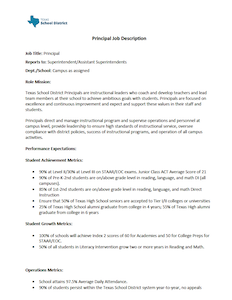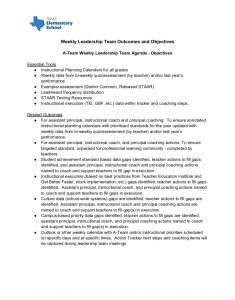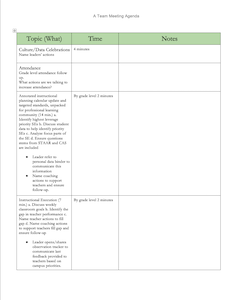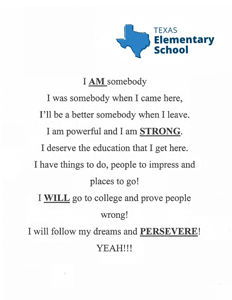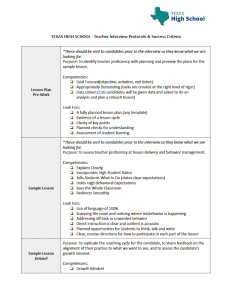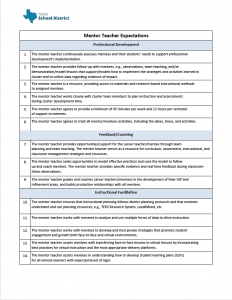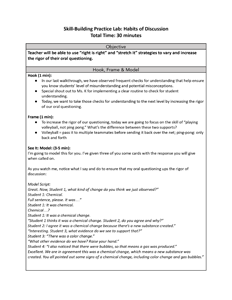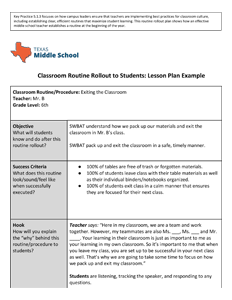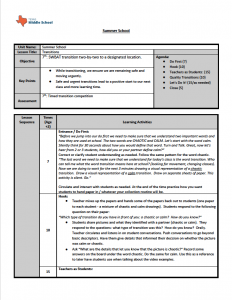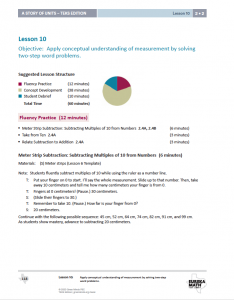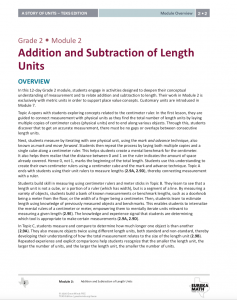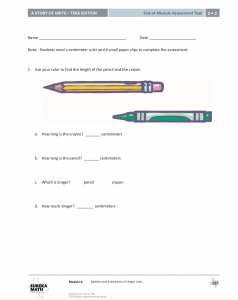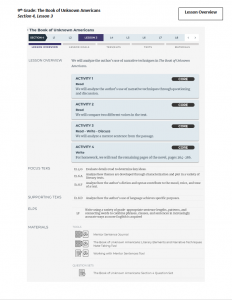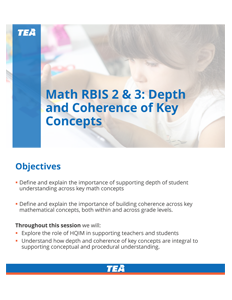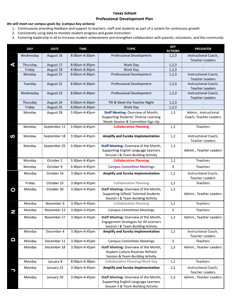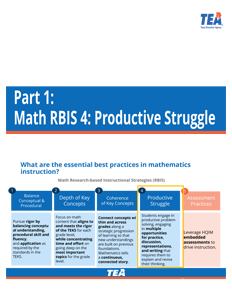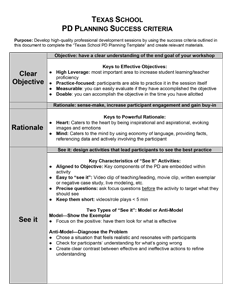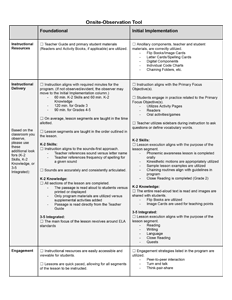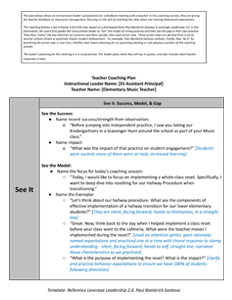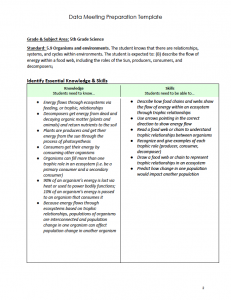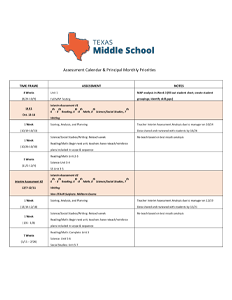ESF In Action
See how effective Texas schools have implemented ESF Essential Actions.
For access to even more resources, register to check out the ESF Model Resource Library.
Already have an account? Log in
1.1 In Action
Essential Action 1.1 is focused on ensuring clear roles and responsibilities for school leadership. Our video and resources highlight this action by showing how effective schools create clear protocols and processes for leadership team meetings.
Principal Job Description
Sample job description for a high school principal that includes role mission, responsibilities, and aligned performance metrics.
Leadership Team Meeting Outcomes and Agenda
Agenda and outcomes for weekly campus leadership team meeting. The agenda includes topics with timestamps, needed tools for the meeting, and recurring meeting outcomes. In addition, it also includes the pre-work leaders complete for this meeting, including the PLC agenda leaders plan weekly.
Leadership Team Meeting Agenda (Table)
Sample agenda from “Leadership Team Outcomes and Agenda” shown in a table form that allows for note-taking, time-keeping, and organization during the meeting.
1.2 In Action
Essential Action 1.2 focuses on a compelling and aligned vision, mission, goals, and values focused on a safe environment and high expectations. Watch our video and explore some resources that show how campuses put their mission and values into action, ensuring their practices and policies demonstrate high expectations and shared ownership of student success.
Mission Statements and Values
Mission, Vision, and Values Artifact
2.1 In Action
Essential Action 2.1 is focused on the recruitment, selection, induction and retention of a highly effective staff. Watch our video and explore resources that demonstrate some ways Texas campuses identify, select and keep strong teachers.
Teacher Interview Protocols
Interview protocols for a teaching candidate, modeling alignment to campus vision and values. Includes success criteria for sample lessons, teacher panel and interview.
Mentor Teacher Expectations
Sample Mentor Teacher Agreement with clearly developed responsibilities and performance expectations that can be used to train and provide feedback to mentor teachers.
3.1 In Action
Essential Action 3.1 focuses on explicit school-wide behavioral expectations and culture routines. Watch our video and explore some resources that illustrate how Texas campuses implement systems and practices aligned to this essential action. For example, you will find a skill building practice lab that supports teachers to implement culture building practices, a classroom routines roll-out plan, and an example lesson plan for rolling out a school-wide culture routine to students.
Skill Building Practice Labs: Habits of Discussion
Classroom Routines Rollout
Student Rollout: Schoolwide Culture Routine
This lesson plan from a Texas middle school is provided to teachers in order to ensure a consistent rollout of a culture system (hallway transitions) to students. The lesson plan includes the “why” for students aligned to the school’s mission, and details exactly how the culture routine should look and sound each day.
4.1 In Action
Essential Action 4.1 is focused on the implementation of high-quality instructional materials at a campus level. Watch our video and explore resources that show alignment between a rigorous assessment, a unit plan, and a lesson plan. In addition, you will find an example of how materials are annotated and adapted to support special populations.
Example Lesson Plan: Elementary Math
This example elementary math lesson plan is a part of the unit plan also presented in ESF in Action. It is aligned to standards, appropriate level of rigor, and research based instructional practices.
Example Unit Plan
This is a unit plan from an elementary math curriculum aligned to the example lesson plan. The unit outlines aligned standards and specific lessons.
Summative Assessment: Elementary Math (Unit)
This elementary math assessment is aligned to the unit plan presented in ESF in Action. The assessment items vary in difficulty and format, giving a comprehensive picture of student knowledge.
Annotated Example Lesson Plan: Secondary ELA
This secondary ELA plan illustrates the success criteria of an effective lesson including alignment to standards, appropriate level of rigor, and research based instructional practices.
TOT RBIS Depth and Coherence
5.1 In Action
Essential Action 5.1 is focused on professional development for effective classroom instruction that addresses instructional strategies responsive to special populations in addition to content-specific and content-agnostic best practices. Watch our video and explore model examples of implementation, including a campus professional development plan, an example of a training on productive struggle, a skill building practice lab, and a professional development planning and success criteria template.
Campus PD Plan
TOT Productive Struggle
Skill Building Practice Labs: Habits of Discussion
PD Planning and Success Criteria
5.2 In Action
Essential Action 5.2 focuses on building teacher capacity through observation and feedback cycles. Watch our video and explore model examples of implementation, including observation tools, teacher trackers, and coaching tools.
Observation Tool
Teacher Action Step Tracker
Teacher Coaching Plan Elementary
5.3 In Action
Essential Action 5.3 focuses on data-driven instruction. You will see a video highlighting examples of high-impact practices at Texas campuses, from strategic assessment calendars to detailed preparation for weekly data analysis.
Data Meeting Preparation Template
This example of leader preparation for a data analysis meeting can also serve as a general template for data analysis at a teacher or teacher team level. The model shows different steps in analysis of student work (break down the standard, ID the gaps, etc). Student work samples are included.
DDI Calendar and Principal Priorities
The following document shows two examples of a leader’s planning of data driven instruction. The first is a detailed assessment calendar that includes DDI moves such as data analysis and time for reteach built around interim and state assessment dates. Additionally, the aligned principal priority plan shows how the leader plans monthly actions based on this assessment calendar.


